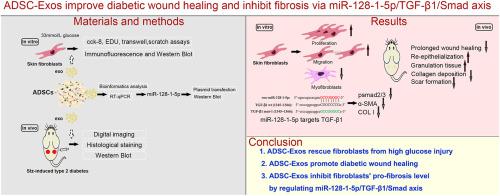当前位置:
X-MOL 学术
›
Mol. Cell. Endocrinol.
›
论文详情
Our official English website, www.x-mol.net, welcomes your feedback! (Note: you will need to create a separate account there.)
Exosomes from adipose-derived mesenchymal stem cell improve diabetic wound healing and inhibit fibrosis via miR-128-1-5p/TGF-β1/Smad axis
Molecular and Cellular Endocrinology ( IF 4.1 ) Pub Date : 2024-03-29 , DOI: 10.1016/j.mce.2024.112213 Qiu Liang , Danlian Zhou , Xiuyu Ge , Peijun Song , Weiwei Chu , Jing Xu , Yan Shen
Molecular and Cellular Endocrinology ( IF 4.1 ) Pub Date : 2024-03-29 , DOI: 10.1016/j.mce.2024.112213 Qiu Liang , Danlian Zhou , Xiuyu Ge , Peijun Song , Weiwei Chu , Jing Xu , Yan Shen

|
Difficult-to-heal wound is a prevalent and significant complication of diabetes, characterized by impaired functionality of epithelial cells such as fibroblasts. This study aims to investigate the potential mechanism of ADSC-Exos promoting diabetic wound healing by regulating fibroblast function. ADSC-Exos were confirmed through TEM, NTA, and Western Blot techniques. The study conducted on rat skin fibroblasts (RSFs) exposed to 33 mmol/L glucose in vitro. We used cck-8, EDU, transwell, and scratch assays to verify the proliferation and migration of RSFs. Furthermore, levels of TGF-β1 and α-SMA proteins were determined by immunofluorescence and Western Blot. RSFs were transfected with miR-128-1-5p mimics and inhibitors, followed by quantification of TGF-β1, α-SMA, Col I and Smad2/3 protein levels using Western Blot. In vivo, the effects of ADSC-Exos on diabetic wounds were assessed using digital imaging, histological staining, as well as Western Blot analysis. In vitro, ADSC-Exos significantly enhanced proliferation and migration of RSFs while reducing the expression of TGF-β1 and α-SMA. In vivo, ADSC-Exos effectively promoted diabetic wound healing and mitigated scar fibrosis. Additionally, ADSC-Exos exhibited elevated levels of miR-128-1-5p, which targets TGF-β1, resulting in a notable reduction in TGF-β1, α-SMA, Col I and smad2/3 phosphorylation in RSFs. In conclusion, our results demonstrated that ADSC-Exos promoted diabetic wound healing, and inhibited skin fibrosis by regulating miR-128-1-5p/TGF-β1/Smad signaling pathway, which provides a promising innovative treatment for diabetic wound healing.
中文翻译:

来自脂肪间充质干细胞的外泌体通过 miR-128-1-5p/TGF-β1/Smad 轴改善糖尿病伤口愈合并抑制纤维化
难以愈合的伤口是糖尿病的一种普遍且重要的并发症,其特征是上皮细胞(例如成纤维细胞)的功能受损。本研究旨在探讨ADSC-Exos通过调节成纤维细胞功能促进糖尿病伤口愈合的潜在机制。 ADSC-Exos 通过 TEM、NTA 和 Western Blot 技术得到证实。该研究对体外暴露于 33 mmol/L 葡萄糖的大鼠皮肤成纤维细胞 (RSF) 进行。我们使用 cck-8、EDU、transwell 和划痕实验来验证 RSF 的增殖和迁移。此外,通过免疫荧光和蛋白质印迹测定TGF-β1和α-SMA蛋白的水平。用 miR-128-1-5p 模拟物和抑制剂转染 RSF,然后使用 Western Blot 定量 TGF-β1、α-SMA、Col I 和 Smad2/3 蛋白水平。在体内,使用数字成像、组织学染色以及蛋白质印迹分析评估 ADSC-Exos 对糖尿病伤口的影响。在体外,ADSC-Exos 显着增强 RSF 的增殖和迁移,同时降低 TGF-β1 和 α-SMA 的表达。在体内,ADSC-Exos 有效促进糖尿病伤口愈合并减轻疤痕纤维化。此外,ADSC-Exos 表现出靶向 TGF-β1 的 miR-128-1-5p 水平升高,导致 RSF 中 TGF-β1、α-SMA、Col I 和 smad2/3 磷酸化显着减少。总之,我们的结果表明,ADSC-Exos 通过调节 miR-128-1-5p/TGF-β1/Smad 信号通路促进糖尿病伤口愈合并抑制皮肤纤维化,为糖尿病伤口愈合提供了一种有前景的创新治疗方法。
更新日期:2024-03-29
中文翻译:

来自脂肪间充质干细胞的外泌体通过 miR-128-1-5p/TGF-β1/Smad 轴改善糖尿病伤口愈合并抑制纤维化
难以愈合的伤口是糖尿病的一种普遍且重要的并发症,其特征是上皮细胞(例如成纤维细胞)的功能受损。本研究旨在探讨ADSC-Exos通过调节成纤维细胞功能促进糖尿病伤口愈合的潜在机制。 ADSC-Exos 通过 TEM、NTA 和 Western Blot 技术得到证实。该研究对体外暴露于 33 mmol/L 葡萄糖的大鼠皮肤成纤维细胞 (RSF) 进行。我们使用 cck-8、EDU、transwell 和划痕实验来验证 RSF 的增殖和迁移。此外,通过免疫荧光和蛋白质印迹测定TGF-β1和α-SMA蛋白的水平。用 miR-128-1-5p 模拟物和抑制剂转染 RSF,然后使用 Western Blot 定量 TGF-β1、α-SMA、Col I 和 Smad2/3 蛋白水平。在体内,使用数字成像、组织学染色以及蛋白质印迹分析评估 ADSC-Exos 对糖尿病伤口的影响。在体外,ADSC-Exos 显着增强 RSF 的增殖和迁移,同时降低 TGF-β1 和 α-SMA 的表达。在体内,ADSC-Exos 有效促进糖尿病伤口愈合并减轻疤痕纤维化。此外,ADSC-Exos 表现出靶向 TGF-β1 的 miR-128-1-5p 水平升高,导致 RSF 中 TGF-β1、α-SMA、Col I 和 smad2/3 磷酸化显着减少。总之,我们的结果表明,ADSC-Exos 通过调节 miR-128-1-5p/TGF-β1/Smad 信号通路促进糖尿病伤口愈合并抑制皮肤纤维化,为糖尿病伤口愈合提供了一种有前景的创新治疗方法。



























 京公网安备 11010802027423号
京公网安备 11010802027423号